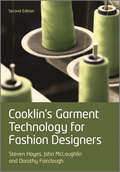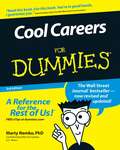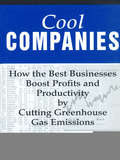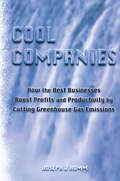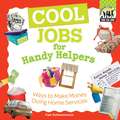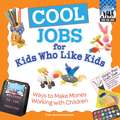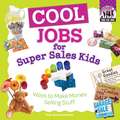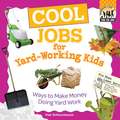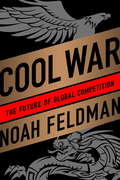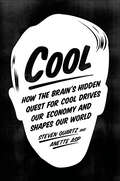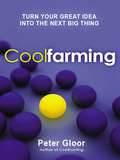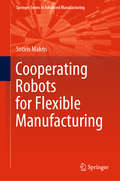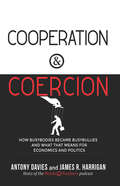- Table View
- List View
Cooklin's Garment Technology for Fashion Designers
by John Mcloughlin Gerry Cooklin Steven George Hayes Dorothy FaircloughBuild the knowledge and understanding of garment technology essential to any designer In today's competitive fashion industry, it is essential that designers have a working understanding of garment technology. This 2nd edition has been comprehensively updated, with in-depth information on stitches, guides and attachments and sewing techniques, all of which are fully illustrated. There are enhanced chapters on machine and equipment technology explaining the uses, features and limitations of garment manufacturing equipment, enabling designers to create products that can be manufactured efficiently and with a high degree of quality. Approached from the fashion designer's mindset, this book features illustrations to help users build their knowledge and understanding Blends theoretical and practical material Updated with the latest and most modern advances in clothing technology Illustrated throughout to help shape the reader's knowledge and understanding of garment technology
Cool Careers For Dummies
by Marty Nemko Richard N. Bolles<p>Every year, thousands of people change careers. Whether you are arecently graduated student looking to put what you studied to good use or an experienced professional looking for a change in routine,finding a career that really suits you can be a daunting task. <p><i>Cool Careers for Dummies</i> helps you discover what you really want out of life, what your passions are, and how well you perform in different environments, and then shows you how to use this information to find a career that suits you. Now revised and up-to-date, this easy-to-use guidebook helps you explore your job options and make clear-minded decisions. This new edition gives you the tools you need to: <p> <li>Search for and find a career that fits your talents <li>Land the job you want <li>Train for your new found career <li>Mold your resume into a masterpiece <li>Put on a stunning interview <li>Improve your career by making the most out of your job <li>Explore the fun and profit of self-employment</li> <p> <p>Along with these features, <i>Cool Careers for Dummies</i> provides a self-assessment section to help you identify your interests. After answering a few questions about yourself,you’ll apply your answers to the Cool Careers Yellow Pages, which profiles more than 500 great careers. It also lets you in on some unwritten codes of the office, such as having integrity,defusing saboteurs, and maintaining office relationships. So what are you waiting for? <i>Get Cool Careers for Dummies</i> and find the job of your dreams today!
Cool Careers for Dummies (2nd edition)
by Marty Nemko Paul Edwards Sarah EdwardsIs your career path unclear? Are you stuck in a job you hate? Don't worry! Now revised and updated, this friendly guide helps you think outside the box and find a job you'll actually like. Written by a trio of renowned job- counseling experts, it's like having your very own dream team of career coaches! Marty Nemko has career coached 1,600 clients. His column appears in the classified section of the LA. Times and on Monster.com. Paul and Sarah Edwards career and self-employment books have sold over 1 million copies. Discover how to: *Locate and land terrific jobs *Get the training you need *Locate jobs, even if you hate networking *Become an employer's #1 job candidate *Make a humdrum job better.
Cool Companies: How The Best Businesses Boost Profits And Productivity By Cutting Greenhouse-Gas Emissions
by Joseph J. RommDespite ongoing negotiations, consensus has not yet been reached on what action will be taken to combat global warming. A number of companies have looked beyond the current stalemate to see the prospect of reducing greenhouse-gas emissions not as a roadblock to growth and innovation but as a unique opportunity to increase profits and productivity. These "cool" companies understand the strategic importance of reducing heat-trapping emissions and have worked to cut their emissions by fifty percent or more. In the process, they have not only reduced their energy bill, but have increased their productivity, sometimes dramatically.In Cool Companies, energy expert Joseph Romm describes the experiences of these remarkable firms, as he presents more than fifty case studies in which bottom line improvements have been achieved by improving processes, increasing energy efficiency, and adopting new technologies. Romm places efforts to reduce emissions in the context of proven corporate strategies, showing managers how they can build or retrofit their operations with the latest technologies to reduce emissions and achieve quick returns on the investment. Case studies illustrate the concept of "lean production" and why systematic efforts to reduce emissions so often lead to productivity gains; explain how changes in office and building design can significantly increase productivity; present options for "cool" power -- from cogeneration to solar, wind, and geothermal energy; and explain energy efficiency in manufacturing.In profiling successful companies such as DuPont, 3M, Compaq, Xerox, Toyota, Verifone, Perkin-Elmer, and Centerplex, among many others, Cool Companies turns on its head the notion that the effort to combat global warming will come with massive costs to the industrial sector. It is a unique and essential business book for anyone concerned with increasing profits and productivity while reducing greenhouse gas emissions.
Cool Companies: How the Best Businesses Boost Profits and Productivity by Cutting Greenhouse Gas Emmissions
by Joseph J. Romm'Cool Companies' turns on its head the idea that measures to avert global warming and climate change will pile massive costs on to the industrial sector. It shows how the smartest companies have been able to make money through the improvements that reduce their greenhouse gas emissions. Industry is going to have to adjust to the new tax and regulatory regimes being introduced around the world, aimed at reducing emissions and meeting internationally agreed targets. The more far-sighted companies have recognised the opportunities this offers. Joseph Romm shows how successful they have been in taking them. Romm profiles more than 50 companies, and describes their experiences in the context of their corporate strategies. All are leaders in their sectors and many are household names such as Xerox, Toyota, BP (now BP Amoco), DuPont, Compaq and 3M. They grasped early on the strategic importance of cutting emissions. By working to do so, through increased efficiency, new technologies and improved processes, they have cut their energy costs and boosted their productivity, often dramatically - improvements which translate straight down to the bottom line. The message is clear. Cool Companies - those prepared to overhaul their policies and innovate - are much more likely to thrive in the new climate for business, while those which have to be dragged backwards into the future will face higher costs and tougher competition.
Cool Hotels
by Jacob Termansen Kim Inglis Pia Marie MolbechCool Hotels showcases the best hotels in India, the Maldives and Sri Lanka. Be it a rustic retreat or a five-star, super-deluxe resort that can hold its own globally, all are at the cutting-edge of the new wave of hotel design and management. Each property has been hand-picked according to a set of criteria that includes a strong design aesthetic, architectural integrity, a commitment to service and a sense of individuality. A million miles away from cookie-cutter approach of chain hotels. Many of the properties have never been featured in guides before and many are just recently opened. With over 500 ravishingly beautiful full color photographs, Cool Hotels is the first in a series of hotel guides focusing on Asia. Ultimately these will be the definitive guides exclusively showcasing the best of Asia's unique places to stay.
Cool Jobs for Handy Helpers: Ways to Make Money Doing Home Services
by Pam ScheunemannKids want to make money! This fun and creative title introduces young readers to the idea of working in a format that is easy to read and use. From cleaning the house to gift wrapping, this book contains kid-tested projects that will have children earning money--and loving it! Instructions and photographs guide kids through the process of business plans, safety, marketing, gathering customer information, and providing a product or service. Background information, materials lists, and additional ideas provide a fun and organized approach to the world of work! Checkerboard is an imprint of ABDO Publishing Company.
Cool Jobs for Kids Who Like Kids: Ways to Make Money Working with Children
by Pam ScheunemannKids want to make money! This fun and creative title introduces young readers to the idea of working in a format that is easy to read and use. From play groups to crafts, this book contains kid-tested projects that will have children earning money--and loving it! Instructions and photographs guide kids through the process of business plans, safety, marketing, gathering customer information, and providing a product or service. Background information, materials lists, and additional ideas provide a fun and organized approach to the world of work! Checkerboard is an imprint of ABDO Publishing Company.
Cool Jobs for Super Sales Kids: Ways to Make Money Selling Stuff
by Pam ScheunemannKids want to make money! This fun and creative title introduces young readers to the idea of working in a format that is easy to read and use. From garage sales to bake sales, this book contains kid-tested projects that will have children earning money--and loving it! Instructions and photographs guide kids through the process of business plans, safety, marketing, gathering customer information, and providing a product or service. Background information, materials lists, and additional ideas provide a fun and organized approach to the world of work! Checkerboard is an imprint of ABDO Publishing Company.
Cool Jobs for Yard-Working Kids: Ways to Make Money Doing Yard Work
by Pam ScheunemannKids want to make money! This fun and creative title introduces young readers to the idea of working in a format that is easy to read and use. From weeds to snow, this book contains kid-tested projects that will have children earning money--and loving it! Instructions and photographs guide kids through the process of business plans, safety, marketing, gathering customer information, and providing a product or service. Background information, materials lists, and additional ideas provide a fun and organized approach to the world of work! Checkerboard is an imprint of ABDO Publishing Company.
Cool Jobs for Young Entertainers: Ways to Make Money Putting on an Event
by Pam ScheunemannKids want to make money! This fun and creative title introduces young readers to the idea of working in a format that is easy to read and use. From carnivals to haunted houses, this book contains kid-tested projects that will have children earning money--and loving it! Instructions and photographs guide kids through the process of business plans, safety, marketing, gathering customer information, and providing a product or service. Background information, materials lists, and additional ideas provide a fun and organized approach to the world of work! Checkerboard is an imprint of ABDO Publishing Company.
Cool Jobs for Young Pet Lovers: Ways to Make Money Caring for Pets
by Pam ScheunemannKids want to make money! This fun and creative title introduces young readers to the idea of working in a format that is easy to read and use. From dog walking to pet accessories, this book contains kid-tested projects that will have children earning money--and loving it! Instructions and photographs guide kids through the process of business plans, safety, marketing, gathering customer information, and providing a product or service. Background information, materials lists, and additional ideas provide a fun and organized approach to the world of work! Checkerboard is an imprint of ABDO Publishing Company.
Cool Jobs in Basketball
by Peter GutierrezChildren's book that describes three people who got jobs in the NBA, but not as players.
Cool War
by Noah FeldmanA bold and thought-provoking look at the future of U.S.-China relations, and how their coming power struggle will reshape the competitive playing field for nations around the world The Cold War seemingly ended in a decisive victory for the West. But now, Noah Feldman argues, we are entering an era of renewed global struggle: the era of Cool War. Just as the Cold War matched the planet's reigning superpowers in a contest for geopolitical supremacy, so this new age will pit the United States against a rising China in a contest for dominance, alliances, and resources. Already visible in Asia, the conflict will extend to the Middle East (U.S.-backed Israel versus Chinese-backed Iran), Africa, and beyond. Yet this Cool War differs fundamentally from the zero-sum showdowns of the past: The world's major power and its leading challenger are economically interdependent to an unprecedented degree. Exports to the U.S. account for nearly a quarter of Chinese trade, while the Chinese government holds 8 percent of America's outstanding debt. This positive-sum interdependence has profound implications for nations, corporations, and international institutions. It makes what looked to be a classic contest between two great powers into something much more complex, contradictory, and badly in need of the shrewd and carefully reasoned analysis that Feldman provides. To understand the looming competition with China, we must understand the incentives that drive Chinese policy. Feldman offers an arresting take on that country's secretive hierarchy, proposing that the hereditary "princelings" who reap the benefits of the complicated Chinese political system are actually in partnership with the meritocrats who keep the system full of fresh talent and the reformers who are trying to root out corruption and foster government accountability. He provides a clear-eyed analysis of the years ahead, showing how China's rise presents opportunities as well as risks. Robust competition could make the U.S. leaner, smarter, and more pragmatic, and could drive China to greater respect for human rights. Alternatively, disputes over trade, territory, or human rights could jeopardize the global economic equilibrium--or provoke a catastrophic "hot war" that neither country wants. The U.S. and China may be divided by political culture and belief, but they are also bound together by mutual self-interest. Cool War makes the case for competitive cooperation as the only way forward that can preserve the peace and make winners out of both sides.Advance praise for Cool War "We are leaving the era of 'Chimerica'--when China and America were economically joined at the hip--and entering the era of what Noah Feldman has justly and wittily dubbed 'Cool War.' Feldman anatomizes the rapid transformation of the Sino-American relationship from an unequal trading partnership into a new and heavily armed ambivalence. Just how cool the conflict stays, Feldman suggests, will be determined not in cyberspace or at sea but in international institutions. Cool War is essential reading for any serious student of the emergent bipolar order in the Asia-Pacific region."--Niall Ferguson, New York Times bestselling author of Colossus: The Rise and Fall of the American Empire and Civilization: The West and the Rest "By giving realism and liberal internationalism their due, and by giving credence to both naked self-interest and legal norms, Noah Feldman's dissection of the United States-China relationship is smart, balanced, and wise."--Robert D. Kaplan, New York Times bestselling author of The Revenge of Geography
Cool: How the Brain's Hidden Quest for Cool Drives Our Economy and Shapes Our World
by Steven Quartz Anette Asp“This engrossing history merges evolutionary biology and economics to explain our spending habits” and show how coolness is at the heart of consumerism (Mental Floss).We live in a world of conspicuous consumption, where the things we buy not only satisfy our needs, but also communicate our values, identities, and aspirations. In Cool, Steven Quartz and Anette Asp bring together groundbreaking findings in neuroscience, economics, and evolutionary biology to show how our concepts of “cool”—be it designer jeans, smartphones, or craft beer—help drive the global economy.Cool puts forth a provocative theory of consumerism based on our brain’s innate status-seeking and “social calculator”. The authors highlight the underlying processes that guide our often-unconscious decision making. They also pull back the curtain on “choice architects” who design store interiors, as well as “coolhunters” who scour Berlin and Tokyo for the latest trends.Quartz and Asp follow the evolution of “cool consumption” from the mid-twentieth century through the emergence of the Internet in the 1990s, finally unpacking the social motivations behind today’s hip, ethical consumption. Taking us from Norman Mailer to normcore, Cool is surprising at every turn, and will forever change the way you think about money, status, and your next purchase.
Coolfarming: Turn Your Great Idea into the Next Big Thing
by Peter GloorPursuing new ideas is clearly the way to gain business advantage in the new millennium. But it's not enough to simply chase after ideas that have already happened. To truly benefit, individuals and organizations have to foster the new creative impulses around them. Coolfarming shows readers how they, like bee keepers, can nurture exciting trends and unleash their creative swarm's output of "next big ideas." Featuring real life examples from Linux to Twilight, from Procter Gamble to Apple, Coolfarming provides readers with invaluable insight on how to: Provide a fertile nurturing ground for developing original ideas * Determine what "cool" means for one's target group, and what attributes the next big thing should possess * Convert creative dreams into real products by enlisting the help of a dedicated and passionate Collaborative Innovation Network * Carry new ideas over the tipping point into widespread phenomena Those who want to stay ahead of the curve and ride a wave of profit need to learn how to find, develop, and popularize the trends of tomorrow. Coolfarming is the answer.
Coop: Market Research
by Youngme Moon Ruth BoltonDaryl Buckmeister, CEO of The Chicken Coop, must decide whether to invest in market research, how much money to spend, and which programs to fund. His two vice presidents (of quality and marketing) have presented very different proposals.
Cooper Industries' Corporate Strategy (A)
by David J. Collis Toby StuartDescribes the development of a successful corporate strategy based on the acquisition and subsequent consolidation of low-technology manufacturing companies. Starting with a company history and discussion of current business segments, the case goes on to detail the innovation of corporate headquarters in strategy formulation and operations. Highlights the synergistic possibilities in alike acquisitions and addresses the issue of long-term value creation in acquisition-oriented firms. Emphasis is placed on the systems and procedures installed to implement the corporate strategy.
Cooper Industries' Corporate Strategy (B)
by Elizabeth Johnson David J. CollisBrings students up to date regarding a recent decision by the chairman.
Cooper Industries, Inc.
by Thomas R. PiperThe executive president of a major industrial company must decide 1) whether to acquire a small hand tool company and, if so, 2) the value and form that the acquisition package should take.
Cooper Pharmaceuticals, Inc.
by Frank V. CespedesTraces the 12-year career of a pharmaceutical salesperson, Bob Marsh, from recruitment to termination. Mr. Marsh has had an uneven career with Cooper Pharmaceuticals, Inc. (CPI) and, after a probationary period, is asked to resign. Following his termination, a number of Marsh's former customers complain vigorously, and CPI's vice president of sales is asked to investigate the matter and to decide what, if anything, to do about it. A rewritten version of an earlier case by D.A. Newton.
Cooperating Robots for Flexible Manufacturing (Springer Series in Advanced Manufacturing)
by Sotiris MakrisThis book consolidates the current state of knowledge on implementing cooperating robot-based systems to increase the flexibility of manufacturing systems. It is based on the concrete experiences of experts, practitioners, and engineers in implementing cooperating robot systems for more flexible manufacturing systems. Thanks to the great variety of manufacturing systems that we had the opportunity to study, a remarkable collection of methods and tools has emerged. The aim of the book is to share this experience with academia and industry practitioners seeking to improve manufacturing practice. While there are various books on teaching principles for robotics, this book offers a unique opportunity to dive into the practical aspects of implementing complex real-world robotic applications. As it is used in this book, the term “cooperating robots” refers to robots that either cooperate with one another or with people. The book investigates various aspects of cooperation in the context of implementing flexible manufacturing systems. Accordingly, manufacturing systems are the main focus in the discussion on implementing such robotic systems. The book begins with a brief introduction to the concept of manufacturing systems, followed by a discussion of flexibility. Aspects of designing such systems, e.g. material flow, logistics, processing times, shop floor footprint, and design of flexible handling systems, are subsequently covered. In closing, the book addresses key issues in operating such systems, which concern e.g. decision-making, autonomy, cooperation, communication, task scheduling, motion generation, and distribution of control between different devices. Reviewing the state of the art and presenting the latest innovations, the book offers a valuable asset for a broad readership.
Cooperating with Nature: Confronting Natural Hazards with Land-Use Planning for Sustainable Communities
by Raymond J. BurbyThis volume focuses on the breakdown in sustainability--the capacity of the planet to provide quality of life now and in the future--that is signaled by disaster. The authors bring to light why land use and sustainability have been ignored in devising public policies to deal with natural hazards. They lay out a vision of sustainability, concrete suggestions for policy reform, and procedures for planning. The book chronicles the long evolution of land-use planning and identifies key components of sustainable planning for hazards. Stressing the importance of balance in land use, the authors offer principles and specific reforms for achieving their visions of sustainability.
Cooperation & Coercion: How Busybodies Became Busybullies and What that Means for Economics and Politics
by Antony Davies James R HarriganThere are only two ways that humans work together: they cooperate with one another, or they coerce one another. And once you realize this fundamental fact, it will change how you see the world. In this myth-busting book, Antony Davies and James R. Harrigan display the wisdom and talent for explaining complex topics that have attracted a devoted audience to their weekly podcast, Words & Numbers, and made them popular speakers around the country. By looking for cooperation and coercion in everyday life, they help make sense of a wide range of issues that dominate the public debate. You&’ll come away from this book with a clear understanding of everything from the minimum wage to taxes, from gun control to government regulations, from the War on Terror to the War on Drugs to the War on Poverty. It turns out that coercion is necessary . . . sometimes. Even in a democracy, we all abide by rules, including plenty that we don&’t agree with, in the name of getting along. But in the end, Davies and Harrigan show, cooperation without question is the key to human happiness and progress. The more we encourage it, the better off we all are. Cooperation & Coercion cuts through heated partisan debates to provide a refreshingly clear and comprehensive understanding of the way the world works.
Cooperation Between Companies and Non-profit Organizations: Taking Responsibility Together: Guidelines for Constructive, Credible and Transparent CSR Projects
by Gabriele Faber-Wiener Bettina GjecajThis book describes how cooperation between companies and non-profit organizations can be successfully structured. Companies want and need to take on more social responsibility, and joint projects with non-profit organizations are therefore more in demand than ever. This is not about maximizing profits through greenwashing or token commitments, but about serious corporate social responsibility projects and purpose strategies that strengthen the reputation on both sides. This requires a structured, transparent approach from the outset.The authors explain the theoretical basis and provide practical guidance on how the initiation of cooperation projects can lead to a credible and sustainable collaboration with added value for all stakeholders. An elementary part of the book is the "Code for Transparent Cooperation", a proven framework that can be applied directly in practice.A book for CSR, communication, marketing and compliance managers in companiesand non-profit organizations who strive for clear rules and an open dialogue at eye level.Anyone who acts as a credible driver of transformation would do well to operate sustainably themselves. Transparency creates credibility and reliability. The more an organization's goals shape the design of partnerships with companies, the more authentic they can appear to the outside world. This guide provides helpful tips and orientation on how to achieve coherence.Dipl.theol. Yvonne Zwick, Chairwoman of B.A.U.M. e.V. - Network for Sustainable Management, HamburgNon-profit organizations are central pillars of our society. Especially in times of disruption and change, their performance is of increasing importance. The prerequisite for this is independence - also in cooperation with companies. This book helps companies and non-profit organizations to understand their counterparts and establish stable collaborations.Dr. Günther Lutschinger, Managing Director of Fundraising Association Austria, ViennaThe time for lone wolves is over. If we are to achieve the Paris climate targets, companies must offer profitable solutions for people and the planet. It's all about: How do I tackle it? The new book by Gabriele Faber-Wiener and Bettina Gjecaj focuses in particular on partnerships with non-profit organizations and aims to prepare the ground for successful collaboration.Daniela Knieling, Managing Director respACT and Network Representative Global Compact Network Austria, ViennaCredibility, responsibility and transparency are the guarantee and basis for the sustainable development of companies. A thriving, trusting cooperation between companies and non-profit organizations helps to answer political and social questions and is a profound approach to solving complex ecological problems.Ernst Ternon, MBA MSc MSc, Head of Green Marketing, Wieselburg Campus, Wiener Neustadt University of Applied Sciences
